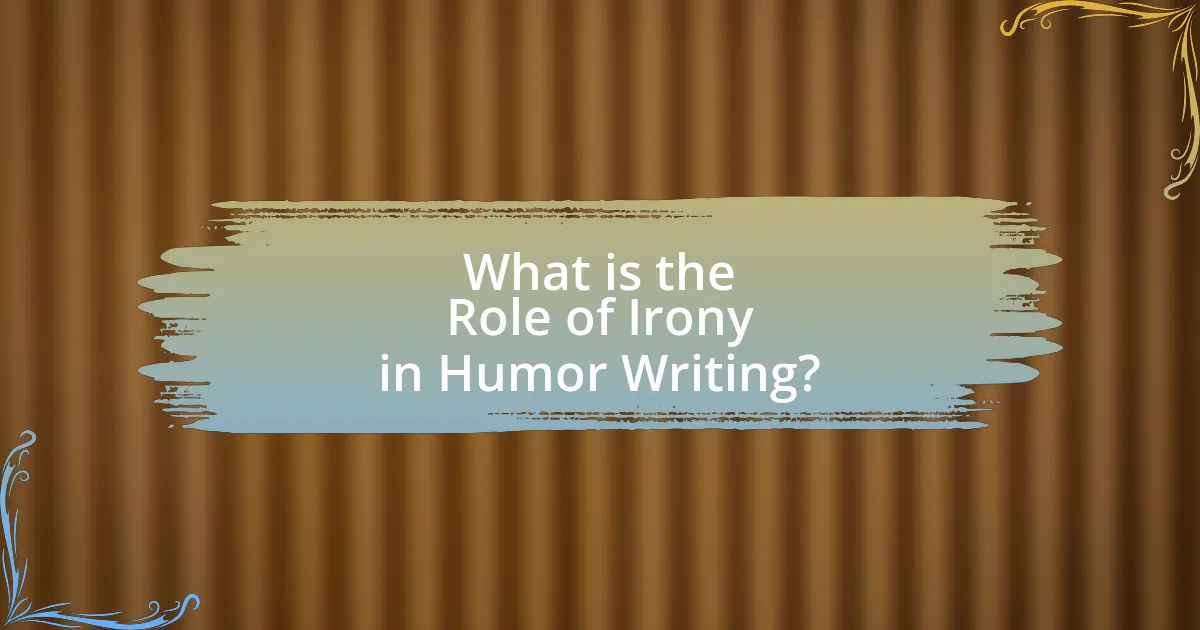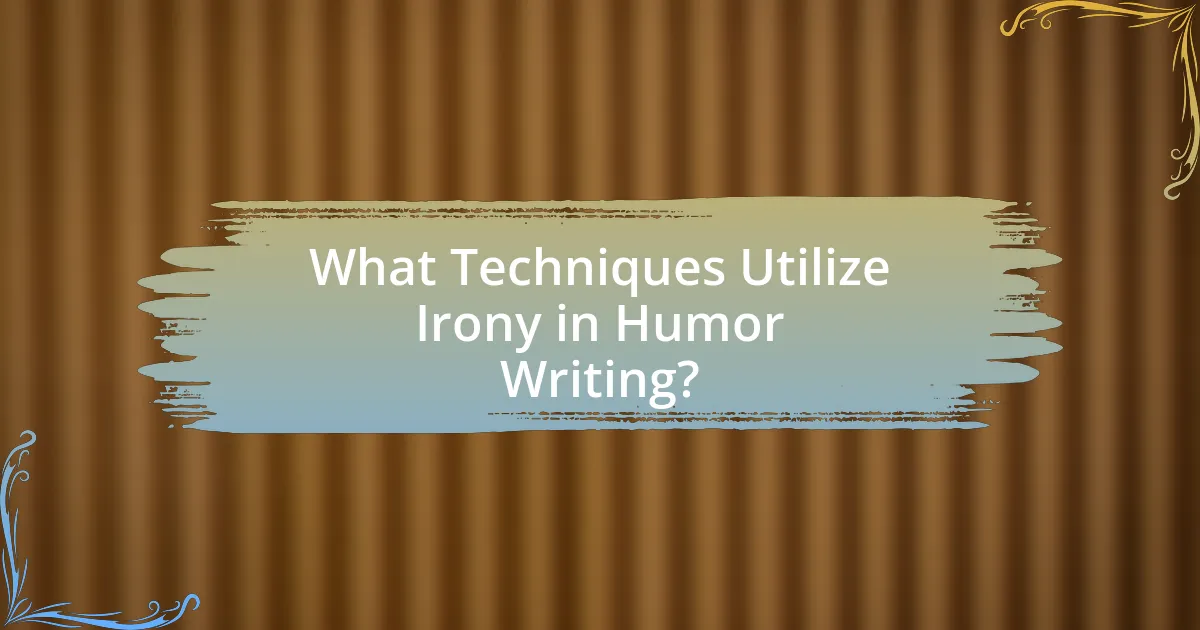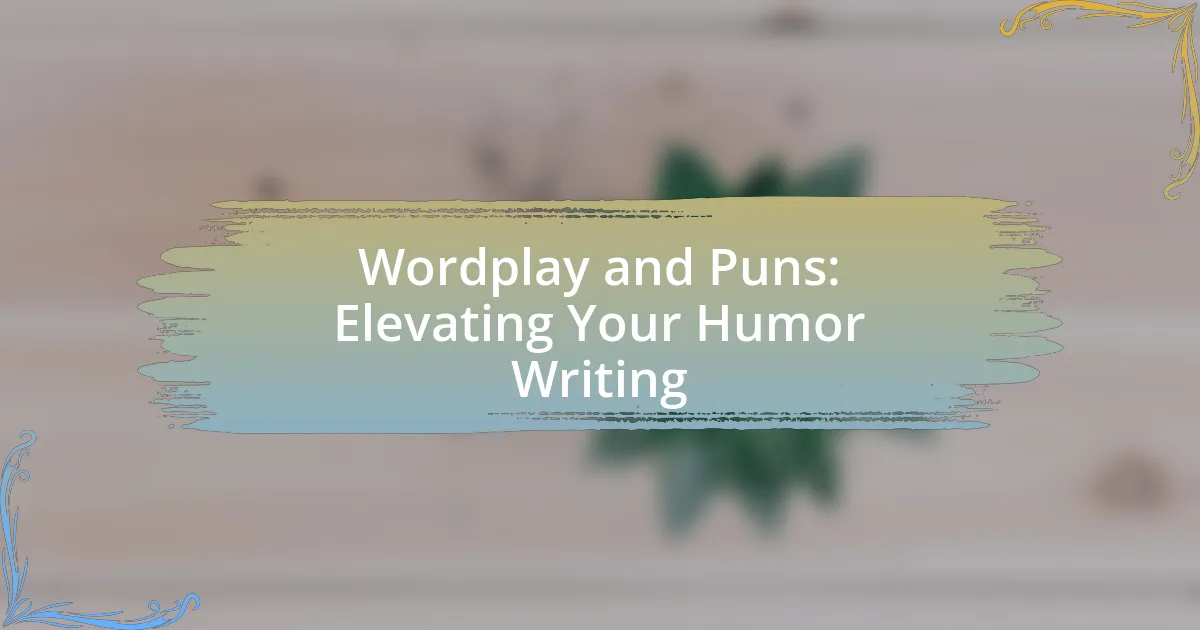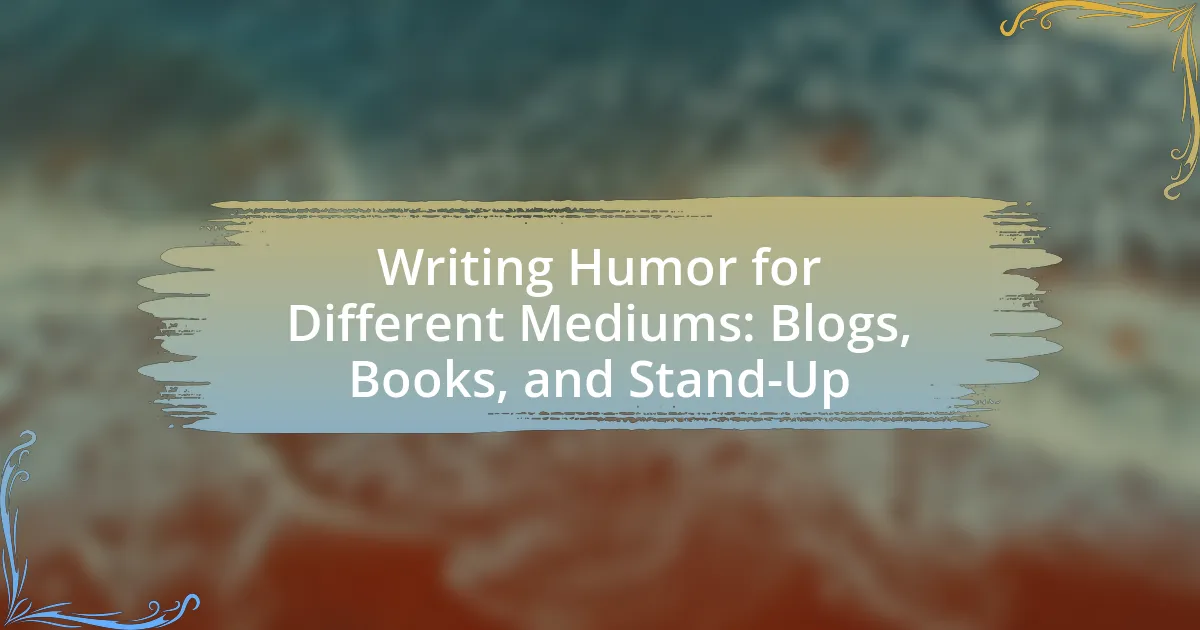The article examines the role of irony in humor writing, emphasizing its significance in creating contrasts between expectations and reality to elicit comedic effects. It explores various types of irony, including verbal, situational, and dramatic irony, and discusses how timing and subtlety enhance their effectiveness. The piece also addresses best practices for incorporating irony, the importance of audience perception, and the risks of overusing irony, ultimately highlighting that a balanced approach can lead to more impactful humor. Additionally, it provides strategies for writers to align audience expectations with irony while maintaining clarity and engagement.

What is the Role of Irony in Humor Writing?
Irony plays a crucial role in humor writing by creating a contrast between expectations and reality, which often leads to comedic effect. This literary device allows writers to convey humor through unexpected twists, where the outcome is contrary to what is anticipated. For example, in the works of authors like Mark Twain and Oscar Wilde, irony is frequently employed to highlight societal absurdities, making the humor more impactful and thought-provoking. The effectiveness of irony in humor is supported by studies in literary theory, which suggest that irony engages readers by prompting them to recognize the discrepancy between the literal and intended meanings, thus enhancing their enjoyment and understanding of the text.
How does irony enhance comedic effect?
Irony enhances comedic effect by creating a contrast between expectations and reality, which often leads to humor. This contrast allows audiences to recognize the absurdity or unexpectedness of a situation, prompting laughter. For instance, in literature and film, characters may find themselves in situations where their actions contradict their intentions, such as a fire station burning down, which highlights the irony and elicits amusement. Studies in humor psychology indicate that irony activates cognitive processes that lead to surprise and enjoyment, reinforcing its role in effective comedic writing.
What are the different types of irony used in humor?
The different types of irony used in humor include verbal irony, situational irony, and dramatic irony. Verbal irony occurs when a speaker says one thing but means another, often for comedic effect, such as sarcasm. Situational irony involves a discrepancy between what is expected to happen and what actually occurs, creating humor through unexpected twists. Dramatic irony arises when the audience knows more about a situation than the characters do, leading to humorous outcomes based on the characters’ ignorance. Each type effectively enhances comedic narratives by subverting expectations and creating layers of meaning.
How does the timing of irony impact its effectiveness?
The timing of irony significantly impacts its effectiveness by enhancing the surprise and emotional response of the audience. When irony is delivered at the right moment, it creates a contrast between expectations and reality, which can amplify humor and engagement. For instance, studies in comedic timing suggest that well-timed irony can lead to greater laughter and appreciation from the audience, as it plays on their cognitive processing of the situation. This is supported by research from the University of California, which found that timing in humor is crucial for eliciting positive emotional reactions, indicating that irony’s impact is maximized when it aligns with the audience’s emotional state and situational context.
Why is less often more when using irony in humor?
Less is often more when using irony in humor because subtlety enhances the impact of the ironic statement. When irony is understated, it allows the audience to engage more actively in interpreting the humor, leading to a greater sense of satisfaction and surprise. Research indicates that humor often relies on cognitive processing, where the audience must recognize the incongruity between the literal meaning and the intended meaning. For example, a study by Martin et al. (2003) in the “Journal of Personality and Social Psychology” found that humor is more effective when it requires the audience to think critically, as this engagement fosters a deeper appreciation for the irony. Thus, minimalistic irony can create a more profound comedic effect by inviting the audience to connect the dots themselves.
What are the risks of overusing irony in writing?
Overusing irony in writing can lead to confusion and misinterpretation among readers. When irony is excessively employed, the intended message may become obscured, causing readers to struggle to discern the author’s true intent. This can result in a disconnect between the writer and the audience, diminishing the effectiveness of the humor. Additionally, frequent irony can create a tone that feels insincere or overly cynical, alienating readers who may prefer more straightforward communication. Studies in literary analysis indicate that balance is crucial; for instance, a 2018 study published in the Journal of Communication found that excessive irony can reduce audience engagement and comprehension.
How can subtlety improve the reception of ironic humor?
Subtlety enhances the reception of ironic humor by allowing the audience to engage in a more thoughtful interpretation of the humor. When irony is presented subtly, it encourages the audience to recognize the contrast between the literal and intended meanings without overt cues, fostering a deeper cognitive engagement. Research indicates that humor appreciation often relies on the audience’s ability to detect incongruities, and subtlety can create a more sophisticated layer of irony that resonates with individuals who enjoy nuanced humor. For example, studies in psychology suggest that subtle irony can lead to greater enjoyment because it requires active participation in understanding the joke, as seen in the work of researchers like Martin and Ford, who found that nuanced humor is often rated more favorably than explicit forms.

What Techniques Utilize Irony in Humor Writing?
Techniques that utilize irony in humor writing include situational irony, verbal irony, and dramatic irony. Situational irony occurs when there is a discrepancy between what is expected to happen and what actually happens, often leading to humorous outcomes. Verbal irony involves saying the opposite of what one means, creating a contrast that can elicit laughter, as seen in sarcastic remarks. Dramatic irony occurs when the audience knows something that the characters do not, which can create tension and humor in storytelling. These techniques are effective because they play on the audience’s expectations and perceptions, making the humor more impactful.
How do writers effectively incorporate irony into their narratives?
Writers effectively incorporate irony into their narratives by creating situations where the intended meaning contrasts sharply with the literal meaning. This technique engages readers by prompting them to recognize the discrepancy between expectation and reality, often leading to humor or critical commentary. For instance, in literature, authors like Jane Austen utilize situational irony to highlight societal norms, as seen in “Pride and Prejudice,” where characters’ actions contradict their stated beliefs, revealing deeper truths about human nature and social conventions. This method not only enhances the narrative’s depth but also encourages readers to reflect on the underlying messages, making irony a powerful tool in storytelling.
What are some common structures that support ironic humor?
Common structures that support ironic humor include incongruity, exaggeration, and reversal. Incongruity occurs when there is a mismatch between expectations and reality, creating a humorous effect; for example, a serious character delivering a trivial statement. Exaggeration amplifies characteristics or situations to absurd levels, making them humorous, such as a character claiming to have run a marathon while actually just walking to the fridge. Reversal involves flipping the expected outcome, such as a character who is supposed to be a hero but ends up causing chaos instead. These structures effectively highlight the contrast between what is expected and what actually occurs, which is fundamental to irony in humor.
How can character development enhance ironic situations?
Character development enhances ironic situations by creating complex, relatable characters whose actions and motivations can lead to unexpected outcomes. When characters evolve in ways that contradict their established traits or beliefs, the resulting irony becomes more impactful and humorous. For example, a character known for their meticulous planning may find themselves in a chaotic situation due to their own overconfidence, highlighting the irony of their failure. This contrast between expectation and reality not only elicits laughter but also deepens the audience’s engagement with the narrative, as they recognize the character’s flaws and growth. Such character-driven irony is a hallmark of effective humor writing, as seen in works like “The Office,” where character quirks lead to humorous misunderstandings and ironic situations.
What role does audience perception play in ironic humor?
Audience perception is crucial in ironic humor as it determines whether the intended irony is recognized and appreciated. The effectiveness of irony relies on the audience’s ability to discern the contrast between the literal meaning and the intended message. Research indicates that irony often requires a shared context or knowledge between the speaker and the audience; for instance, studies show that individuals who understand the social cues and cultural references embedded in ironic statements are more likely to find them humorous. This shared understanding enhances the comedic impact, as the audience’s perception aligns with the humorist’s intent, creating a more engaging and enjoyable experience.
How can cultural context influence the understanding of irony?
Cultural context significantly influences the understanding of irony by shaping the norms, values, and references that individuals use to interpret messages. For instance, in cultures where direct communication is valued, irony may be perceived as confusing or insincere, while in cultures that embrace indirect communication, irony can be a sophisticated form of expression. Research by Attardo (1994) in “Linguistic Theories of Humor” highlights that the interpretation of irony relies heavily on shared knowledge and cultural cues, indicating that what is considered ironic in one culture may not translate effectively to another. This demonstrates that cultural context is essential for recognizing and appreciating irony in humor writing.
What strategies can writers use to align audience expectations with irony?
Writers can align audience expectations with irony by establishing a clear context and using subtle cues that signal the intended irony. By setting up a scenario that appears straightforward, writers can create a contrast between the audience’s expectations and the actual outcome, which is essential for effective irony. For instance, in humor writing, a character might confidently predict a positive outcome, only for the situation to take an unexpected turn, highlighting the irony. This technique relies on the audience’s ability to recognize the discrepancy between what is said and what is meant, which is often reinforced through tone, word choice, and situational context. Research indicates that irony is most effective when audiences are primed to expect a certain narrative direction, allowing them to appreciate the humor in the twist.

What are the Best Practices for Using Irony in Humor Writing?
The best practices for using irony in humor writing include maintaining clarity, ensuring the audience understands the context, and using subtlety to enhance comedic effect. Clarity is crucial because irony relies on the audience recognizing the contrast between expectation and reality; if the irony is too obscure, it may confuse rather than amuse. Context is essential, as it frames the irony and helps the audience grasp the intended humor. Subtlety is important because overt irony can come off as heavy-handed, while a more understated approach allows the humor to emerge naturally, making it more relatable and effective. These practices are supported by studies in humor theory, which emphasize the role of cognitive processing in understanding irony, indicating that well-crafted irony can lead to greater audience engagement and enjoyment.
How can writers balance irony with other comedic elements?
Writers can balance irony with other comedic elements by strategically integrating situational humor, wordplay, and character-driven comedy. This approach allows for a layered comedic experience where irony serves as a foundation while other elements enhance the overall humor. For instance, situational humor can create scenarios that highlight the absurdity of ironic statements, making them more impactful. Additionally, wordplay can complement irony by providing clever twists that reinforce the ironic message. Character-driven comedy adds depth, as characters reacting to ironic situations can evoke empathy and laughter simultaneously. This multifaceted approach ensures that irony does not overshadow other comedic elements but rather works in harmony to create a richer comedic narrative.
What are effective ways to introduce irony without losing clarity?
Effective ways to introduce irony without losing clarity include using clear context, maintaining a consistent tone, and employing straightforward language. Clear context ensures that the audience understands the situation or statement being presented, which is crucial for irony to be recognized. A consistent tone helps to reinforce the ironic message, as fluctuations in tone can confuse the audience. Additionally, straightforward language minimizes ambiguity, allowing the irony to shine through without misinterpretation. For instance, in humor writing, a well-known example is the use of situational irony, where the outcome is starkly different from what is expected, such as a fire station burning down, which is easily understood and retains clarity.
How can feedback help refine the use of irony in humor writing?
Feedback can significantly refine the use of irony in humor writing by providing insights into audience perception and comprehension. When writers receive feedback, they can identify whether their intended irony is understood or misinterpreted, allowing them to adjust their language, tone, and context accordingly. For instance, studies show that humor often relies on shared knowledge and context; feedback can reveal gaps in this understanding, prompting writers to clarify or enhance their ironic statements. This iterative process of receiving and applying feedback leads to more effective and nuanced use of irony, ultimately improving the overall impact of the humor.
What tips can improve the effectiveness of ironic humor?
To improve the effectiveness of ironic humor, one should focus on clarity, context, and timing. Clarity ensures that the audience understands the underlying message, while context provides the necessary background for the irony to resonate. Timing is crucial, as delivering the ironic statement at the right moment enhances its impact. Research indicates that effective irony often relies on the audience’s ability to recognize incongruities, which can be facilitated by these elements. For instance, a study published in the journal “Cognitive Science” by authors such as Giora and Fein (2000) highlights that irony is more appreciated when the audience is primed with relevant information, reinforcing the importance of context and clarity in humorous delivery.
How can writers identify their unique voice while using irony?
Writers can identify their unique voice while using irony by experimenting with personal experiences and perspectives that resonate with their individual style. This process involves reflecting on their beliefs, values, and humor, which allows them to infuse irony in a way that feels authentic. For instance, a study by the University of California found that writers who incorporate personal anecdotes into their ironic statements create a stronger connection with their audience, enhancing the effectiveness of their humor. By blending their unique viewpoints with irony, writers can develop a distinctive voice that stands out in humor writing.
What common pitfalls should writers avoid when using irony?
Writers should avoid over-explaining irony, as it can diminish its impact and confuse the audience. When irony is excessively detailed or clarified, it loses its subtlety, which is essential for effective humor. For instance, in literature, authors like Oscar Wilde often employed understated irony, allowing readers to infer meaning without explicit explanation. Additionally, writers should steer clear of using irony inappropriately, such as in serious contexts where it may come off as insensitive or offensive. This misapplication can alienate readers and undermine the intended humor. Lastly, writers must be cautious of relying too heavily on irony, as it can lead to a lack of genuine emotion or connection with the audience, making the humor feel hollow.





